Welcome to your complete FAQ guide to RV and camper lead-acid batteries. This free mini Ebook contains the answers to many (hopefully all!) common RV owner questions about camper batteries: how they work, how to charge, why they break, etc.
What Is an RV Battery?
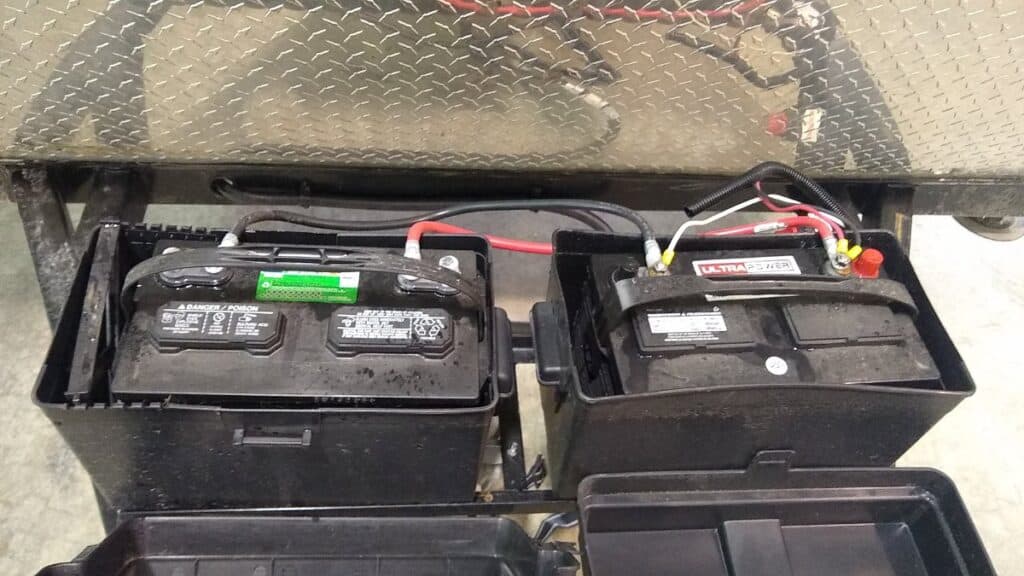
At the risk of insulting your intelligence, a battery is a device that stores electrical energy. A basic battery is made up of an anode, a cathode, and an electrolyte. Batteries can be smaller than the width of a human hair or as large as a football field.
All RVs and campers have batteries onboard! These batteries provide 12-volt (12V) direct-current (DC) power for your 12V electronics, such as ceiling lights and roof fans. They are usually 40-60 lbs and the size of a lunchbox.
RV house batteries may look like car starting batteries, but they are built differently inside. You’ll quickly ruin a starting battery if you use it as an RV house battery! Instead, you want a deep-cycle battery.
What Are the Different Types of RV Batteries?
Modern campers have one of three types of batteries.
Flooded-Lead Acid
Meet Old Faithful: The simple flooded lead-acid battery. These batteries can lose water in their cells due to overcharging or evaporation, so they should be checked manually. Only used distilled water!
Flooded batteries are also known as “wet” batteries.
Sealed Lead-Acid (AGM)
AGM batteries are a type of lead-acid battery, but the internal construction has been improved. They offer several benefits:
- Can be mounted in many orientations
- More resistant to shock and vibration
- Don’t require maintenance
You may hear AGM batteries referred to as sealed lead-acid (SLA) or valve-regulated (VRLA). This isn’t wrong – one is the subset of the other.*
A common misconception is that AGM batteries can be stored inside a camper or RV. That is not true. If sufficient pressure builds up inside the battery, a valve will release hydrogen gas, which is explosive in sufficient concentration. Batteries stored inside a vehicle must be vented to the outside!
*Technically, an AGM >> VRLA >> SLA >> lead-acid battery.
Another type of SLA battery is called a gel cell battery, but they are rarely used in RVs.
Lithium Phosphate
Lithium batteries are the darlings of modern RV owners. They have an entirely different chemistry with different charge and discharge requirements.
Benefits of lithium batteries include:
- Lighter weight
- Discharge down to 20% instead of 50%.
- Can be installed inside RV without venting.
- Faster charging and discharging.
What Size RV Battery Group Do I Need?
Group = size. It’s like wearing a Size 9 shoe or 38×36 jeans. Battery group sizes are specified by the Battery Council International.
RV house batteries are usually Group 24, Group 27, or Group 31. All other things being equal, bigger is better. Bigger batteries offer higher energy capacity and more durability. Ensure your battery box is a matching size, too.
What Is an RV Battery Bank?
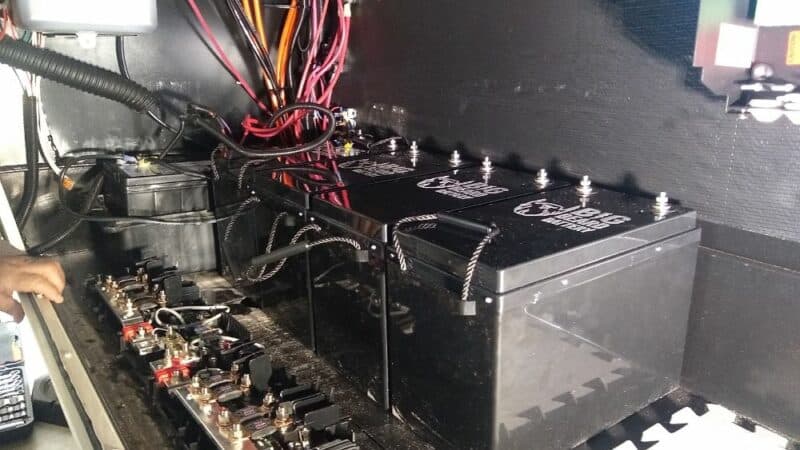
Want to hear a joke?
“If a banker and a lawyer were both drowning and you could only save one, would you go to lunch or read the paper?”
Anyway … an RV battery bank is simply a group of batteries.
A group of batteries is called a “bank,” like a group of lions is called a “herd” or a group of pigs is called a “sounder.”
A lot of RV owners and campers prefer multiple batteries, either 6V golf cart batteries in series of 12V batteries in parallel. Compared to a single battery, a bank provides:
- Extra energy capacity
- Heavy-duty hardware
- Some peace of mind in case one battery kicks the bucket
RV Deep-Cycle Battery Vs Marine Battery?
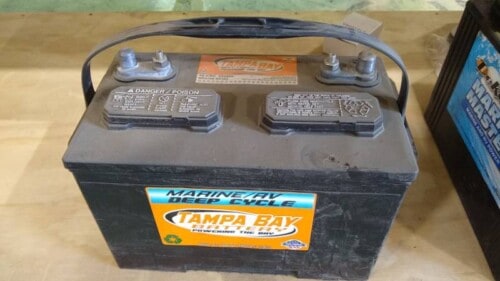
Despite what your RV salesman may tell you, no, marine batteries and RV deep-cycle batteries are not the same! They do share some similarities:
- Both are lead-acid batteries.
- Both are capable of being discharged and recharged.
- Both use the same chargers.
However, the intestines of a true deep-cycle battery aren’t quite the same as a marine-style battery.
Deep-cycle batteries are dedicated to getting the most energy capacity out of your battery. Because they are dedicated to one thing, they’re very good at it. However, they shouldn’t be quickly discharged.
Marine batteries are a jack-of-all-trades. They offer limited discharge capacity in exchange for higher cranking amps. They can both turn over a small engine and power your lights, but they don’t do either to the best of their ability.
Lots of RVers use marine “deep-cycle” batteries. If you dwell mostly in developed campgrounds, you won’t suffer if you use marine batteries.
However, if you venture forth into the boondocks, you’ll appreciate the additional energy capacity of a true deep-cycle battery.
What Safety Gear Should I Wear when Servicing a Battery?
Batteries are mostly lead compounds and sulfuric acid, both of which are not good for the human body!
- Protect your face from splashing acid with a face shield – not just safety glasses
- Wear chemical-resistant gloves and clothing.
If the electrolyte spills on your skin, wash the affected area thoroughly with water for at least 15 minutes.
Here are some other safety precautions.
- I recommend you use install rubber boots on the battery terminals. This will prevent sparking and short-circuiting if, say, you accidentally drop a metal tool across the terminals.
- Speaking of which, you can wrap the handles of your electrical tools in several layers of vinyl electrical tape to reduce the chances of sparking or shock.
Can an RV Battery Freeze?
Yes, an RV battery can freeze. But if you’re following the rule of never discharging your lead-acid battery less than 40-50% of capacity, then you have little to worry about.
As a battery is charged, more of the electrolyte is pure water and less sulfuric acid. So its freezing temperature threshold rises. Thankfully, if you camp at temperatures above 0 degrees Fahrenheit and never discharge your battery below 50%, then you’ll never suffer a frozen battery.
However, if A) you leave in Northern Alaska or B) you accidentally discharge your battery below 20%, then you might freeze your battery. Usually, a frozen battery is a ruined battery. The ice breaks electrical connections, bends plates, and otherwise wreaks havoc.
NEVER attempt to recharge a frozen battery! Just chuck it. It won’t work, it’ll overheat the battery, and the battery could very well explode. It’s a serious safety hazard.
Can an RV Battery Get Wet?
If you’ve accidentally splashed a little water on your battery’s plastic housing, then don’t fret.
However, you want to keep your battery as dry as possible. A puddle around the terminals can cause an electrical short and an explosion!
Submerging the base of your battery in water, especially salt water, can also increase the self-discharge rate.
Plus, water will cause the terminals and connections to corrode. You can reduce the corrosion by applying dielectric grease to the battery terminals and installing terminal cap covers.
So be sure your battery is stored inside a battery box, preferably in a sealed compartment or underneath a container.
Why Is My RV Battery Not Charging?
If it hasn’t happened to you, it will. Sometimes your battery doesn’t get what it wants, throws the toy across the room, and starts whining.
Somewhat Obvious Fixes
Let’s begin with the equivalent of the computer IT response, “Have you tried turning your computer off and on?”
Have you tried unplugging and plugging back in your camper? Do other appliances work? Are you sure it’s not a “blonde moment,” like the campground power pedestal doesn’t work or your electrical cord fell out of the power inlet?
How do you know the battery isn’t charging? Have you confirmed the battery’s state of charge with a voltmeter or battery monitor? If using a battery tester, are you sure the tester works correctly?
Next, just inspect the battery itself. Do you see any wires burnt, broken or frayed? Are the terminals severely corroded? Is the battery plastic housing cracked or bulging? If so, you’ve probably just found your problem!
However, if you’re 100% sure that A) you are plugged into power and B) the battery is actually not charging, here are some other possibilities.
Connectivity Problems
Check the fuse. Go to your converter/charger or panel center and check the battery reverse hook-up fuse, usually 30- to 50A. Replace bad fuses with the same type and amperage. Some campers may have an inline fuse between the battery and the panelboard.
Check the circuit breaker. There should be an automatic-reset thermal circuit breaker within a few feet of the battery on the main positive wire. Old or corroded circuit breakers might not be able to reset after being tripped.
Find the battery disconnect switch and make sure it’s turned to “ON.” Some designs won’t allow a battery to charge without the switch enabled.
Is the RV battery properly grounded? There should be a heavy-gauge wire going directly from the negative battery terminal to a lug on the chassis frame. Your panelboard should be grounded as well.
Are the battery terminals severely corroded? Severe oxidation can prevent the terminals from making good contact with the lugs. A thorough cleaning and dielectric grease will work wonders.
Broken Converter
It’s rarer than you think, but sometimes a converter control board gets fried. There’s no easy over-the-counter fix, but you can easily purchase a replacement control board. You can either contact the manufacturer directly or find one in stock at an online retailer.
Bad Battery
If any of the following scenarios occurred, you may have a true “bad battery.”
- You over-discharged your battery – say, down to 15% capacity.
- You tried to charge your battery while it was frozen.
- You stored your battery in high heat for an extended period.
- You dropped a wrench across the terminals and shorted it out.*
*P.S. Don’t ever try that. The wrench can weld itself to the terminals and cause the battery to explode like a chemical bomb, throwing sulfuric acid all over the room and into your face.
Can I Overcharge My RV Battery?
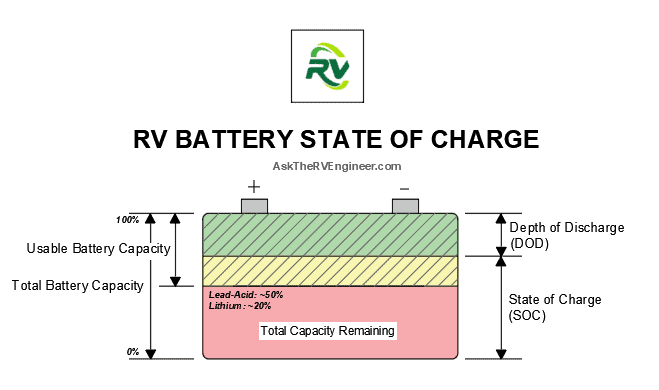
For many years, RVs and campers were sold with crude single-stage converters. These converters supplied a single charging voltage, normally around 13.8 volts, to lead-acid batteries.
You couldn’t leave your batteries hooked up to a single-stage charger for too long. Otherwise, the electrolyte would “boil over,” and you’d ruin your battery in short order.
Thankfully, virtually no manufacturer uses single-stage chargers anymore. You’ll only find them hanging out in old campers on Craigslist and Facebook Marketplace.
If you’re still using a single-stage charger, STOP. Pause this article right now, and go spend $150 on a 3-stage charger. It’s the best $150 you can spend on an RV.
Now, 3- and 4-stage chargers aren’t perfect, but they will virtually never overcharge a lead-acid battery. In the float stage, they essentially act as a trickle charger, merely maintaining a full state of charge.
How Does an RV Battery Disconnect Work?
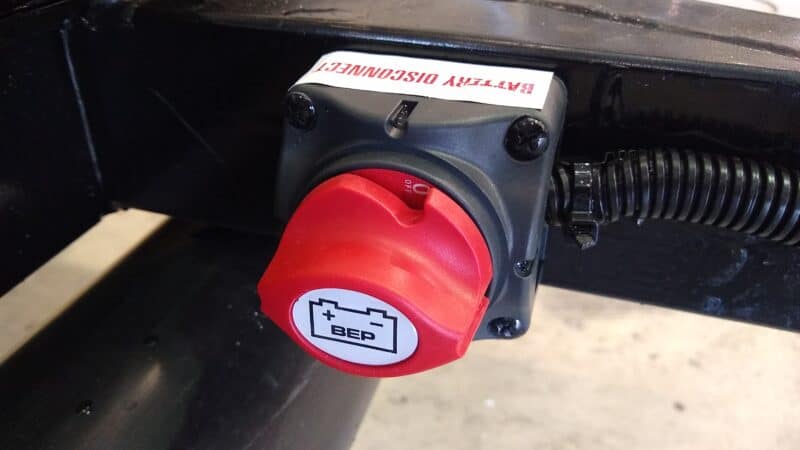
A battery disconnect is a manual switch between your battery and your panelboard.
It’s both a safety switch and an energy conservation tool.
A battery disconnect switch allows you to shut off all power from the battery. If you need to service the battery, diagnose electrical issues, or stop a ground fault or short circuit, you can safely disconnect power.
A battery disconnect switch allows you to prevent parasitic load losses. If you’re storing your RV, you don’t want the panelboard, CO2 detector, clock or other features to slowly drain and kill your battery! You can disable the flow of electricity completely with the disconnect switch.
Does an RV Battery Charge While Towing?

I may have almost gotten into a fistfight over this question, actually.
- The myth: My tow vehicle charges my RV battery while driving!
- The truth: Most (not all) tow vehicles maintain, but do not FULLY charge, RV house batteries.
Batteries require a high voltage to fully charge. Charging at lower voltages will never fully charge a battery, no matter how long you try it.
The weakest link breaks the chain. If you have an underpowered alternator, small-gauge wiring, corroded wire connections, super-long wire runs, or AGM batteries, then you may find that your tow vehicle can only charge your battery to 70-80% of capacity.
If this is your problem, you need a DC-to-DC in-vehicle battery charger. These are true multi-stage battery chargers, and they’ll generate sufficient voltage to charge your auxiliary batteries. Of these, the industry leader is Redarc.
How to Wire an RV Battery in Series or Parallel?
Here’s a simple chart showing you how series and parallel battery connections work.
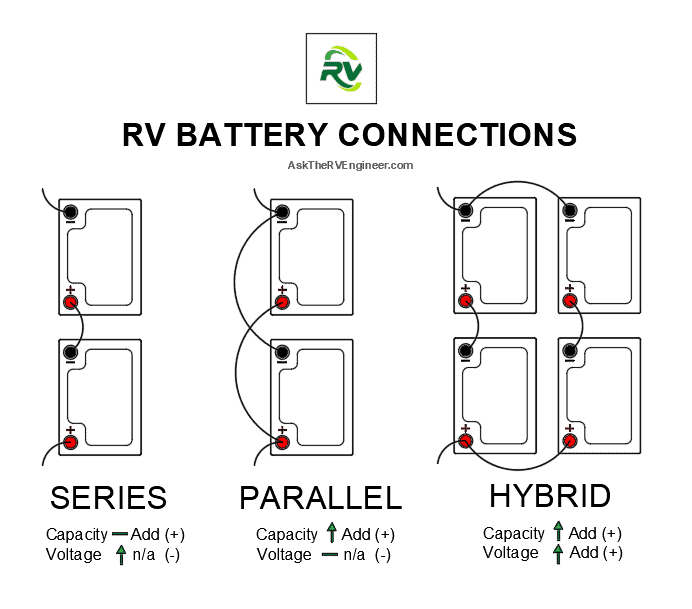
Simple DC batteries can be wired in two basic configurations: series and parallel.
- A series connection increases the voltage of a battery bank. Add the individual voltages to calculate the total system voltage.
- A parallel connection increases the energy capacity of a battery bank. Add the individual capacities to calculate the total system capacity.
If you’re connecting two 6V golf cart batteries, you’ll want a series connection.
- Example: Two 110Ah, 6V batteries wired in series = 110Ah, 12V.
If you’re connecting two 12V AGM batteries, you’ll want a parallel connection.
- Example: Two 110Ah, 12V batteries wired in parallel: 220Ah, 12V.
Campers often use series wiring when connecting two heavy-duty 6V golf cart batteries.
Parallel wiring is more common when, say, upgrading to a 200Ah system for boondocking.
Where to Store RV House Batteries?
All lead-acid batteries, even “sealed” types like AGM, can release explosive gases if overcharged. For that reason, NFPA 1192 code requires that batteries be isolated from the interior.
- Travel trailer: Commonly mounted on the A-frame tongue in plastic boxes underneath a protective tongue box cover
- Fifth-wheel: Commonly located in a vented compartment accessible via the camper’s front wall, isolated from the camper interior.
- Motorhome: Commonly located in the vehicle’s “basement,” mounting on a sliding platform.
When Should I Replace My RV Battery?
You should replace your battery when it can no longer hold a reasonable charge. For most campers, this is 70-80% of original capacity.
A battery’s life is best rated in charging cycles, not years.
If you carefully maintain your batteries by avoiding extreme temperatures and following best practices for charging cycles, your deep-cycle battery could easily last 5-6 years, or even more!
If you don’t follow RV battery best practices, you might be replacing your batteries every 2 years. More than anything else, extreme heat and deep discharges below 40-50% capacity ruin your battery life.
When replacing your RV batteries, it is best practice to replace all batteries at the same time.* This is especially important if you’re replacing batteries wired in series!
*There’s actually a lot more to this common rule of thumb. Technically, older batteries don’t ruin new batteries if wired in parallel. However, since your batteries were likely exposed to the same conditions that caused one to fail, it is still best practice to replace all.
Leave a Reply